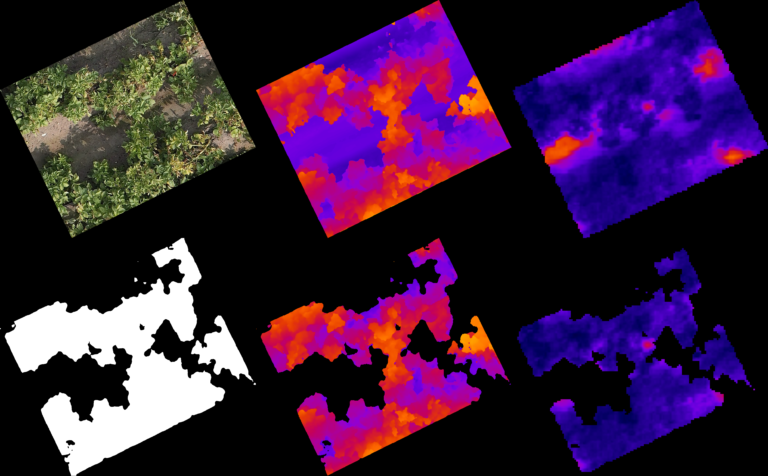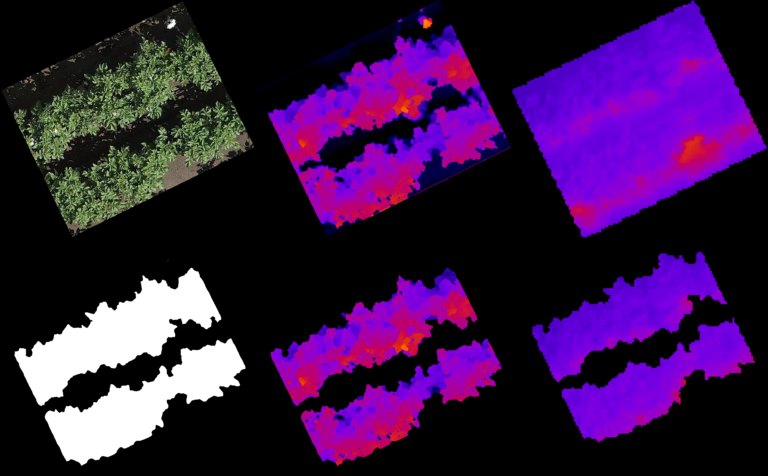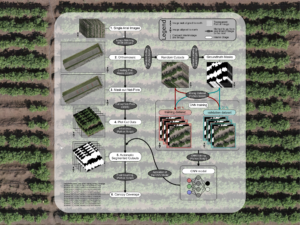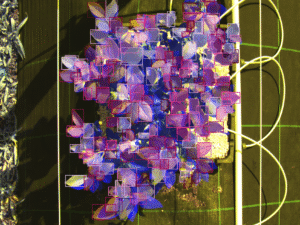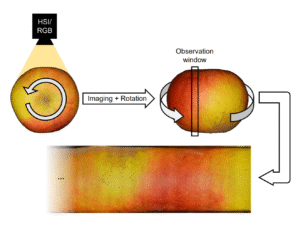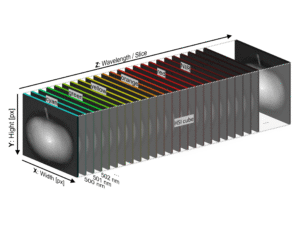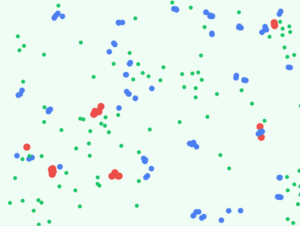This blog explores the development of a complete workflow—from drone images to accurate...
Expanding the Pipeline: Canopy Height and Canopy Temperature
A Blog Post
This blog post explores how to expand a drone-based pipeline for crop analysis. By incorporating height and thermal data, along with canopy coverage, a more comprehensive understanding of crop health and growth can be achieved.
Recap
In a previous blog post, I explored a pipeline for accurately measuring canopy coverage using drone imagery and deep learning. This pipeline, powered by a convolutional neural network (CNN), effectively distinguishes canopy pixels from non-canopy pixels, even under challenging conditions.
Expanding the Pipeline
To further enhance the understanding of crop health and growth, I expanded the pipeline to incorporate canopy height and canopy thermal data. These additional dimensions could provide valuable insights into plant development and stress responses.
Canopy Height
To estimate canopy height, I utilized the digital elevation map (DEM) functionality within Agisoft Metashape. This generated an orthomosaic from the RGB images (see former post) where pixel values represented relative height. To convert these relative heights to absolute values, a multiple ground control points (GCPs) at fixed locations within the field were established. By measuring the height at these GCPs manualy and correlating them with corresponding points in the relative height orthomosaic, I was able to fit a linear regression model. This model allowed to convert the relative heights to absolute heights across the entire orthomosaic.
After converting to absolute heights, the previously generated plot masks (see former post) were applied to isolate individual plots. To ensure accurate height measurements, I excluded soil pixels using the CNN-derived canopy masks (see former post). To account for the uneven terrain of potato ridges, a pre-emergence height image (averaged along the ridge direction) was subtracted from the absolute height image. The average pixel value within the resulting image represented the average canopy height above ground for each plot at each image acquisition date.
Canopy Temperature
Canopy temperature was measured using a UAV-based FLIR thermal sensor. Thermal images were processed in Agisoft Metashape to generate a thermal orthomosaic, where pixel values represented relative temperature. To convert these relative temperatures to absolute values, the temperature of multiple targets (painted aluminum sheets) was measured during each UAV flight. By correlating these measured temperatures with corresponding pixel values in the thermal orthomosaic, I fitted a linear regression model to convert relative temperatures to absolute temperatures.
Similar to the canopy height analysis, the plot masks were applied to isolate individual plots and excluded soil pixels using the CNN-derived canopy masks. The average pixel value within each masked thermal image represented the average canopy temperature for each plot at each image acquisition date.
Integrating Height and Thermal Data with Canopy Coverage
By combining canopy coverage, height, and thermal data, a more comprehensive understanding of crop health and development can be gained. For example:
- Early Stress Detection: Monitor changes in canopy temperature to identify potential stress factors like drought.
- Crop Growth Monitoring: Track canopy height and coverage to assess plant growth rates and biomass accumulation.
Conclusion
The expanded pipeline, incorporating height and thermal data, provides a powerful tool for plant scientists and agronomists. By leveraging the capabilities of drone technology and deep learning, valuable insights into crop health, growth, and yield potential could be gained.
Additional Considerations
- Data Quality: Ensure high-quality drone imagery and accurate calibration of height and thermal data. However, a (hopefully) future project of mine will test, how high the spatial resolution actually has to be, to still gain meaningful insides, but possibly change to a fixed-wing UAV platform (which will resut in a lower spatial resolution).
- Automation: I further want to automate as much of the pipeline as possible to streamline the workflow and reduce human error.
Examples
In both images the same data for two different dates and two different plots can be seen:
- Top row (left to right):
- Top down RAW RGB image (see former post)
- digital elevation map (DEM), derived from the RGB image to the left: blue = low (close to the ground), orange = high
- Thermal Image: blue = cold (~15 °C); orange = hot (~ 40 °C)
- Lower row (left to right):
- Canopy mask, derived from the RGB image using a neural network (see former post)
- Digital elevation map (DEM) with the applied canopy mask
- Thermal image with the applied canopy map
Read Part one of this Post:
Other Posts from all Categories
PhenoSelect: Training a Neural Network Because I Refuse to Click on 100,000 Leaves
An introduction to PhenoSelect, an open-source deep learning pipeline designed to automate leaf...
How to Image a Whole Apple
A deep dive into the process of building a custom hardware and software...
Beyond the Naked Eye OR Why More Data Isn’t Always Better
An exploration into how hyperspectral imaging and machine learning can be used to...
Introduction to Modeling
Modeling is a powerful tool for bioscientists to understand complex systems. This introduction...

